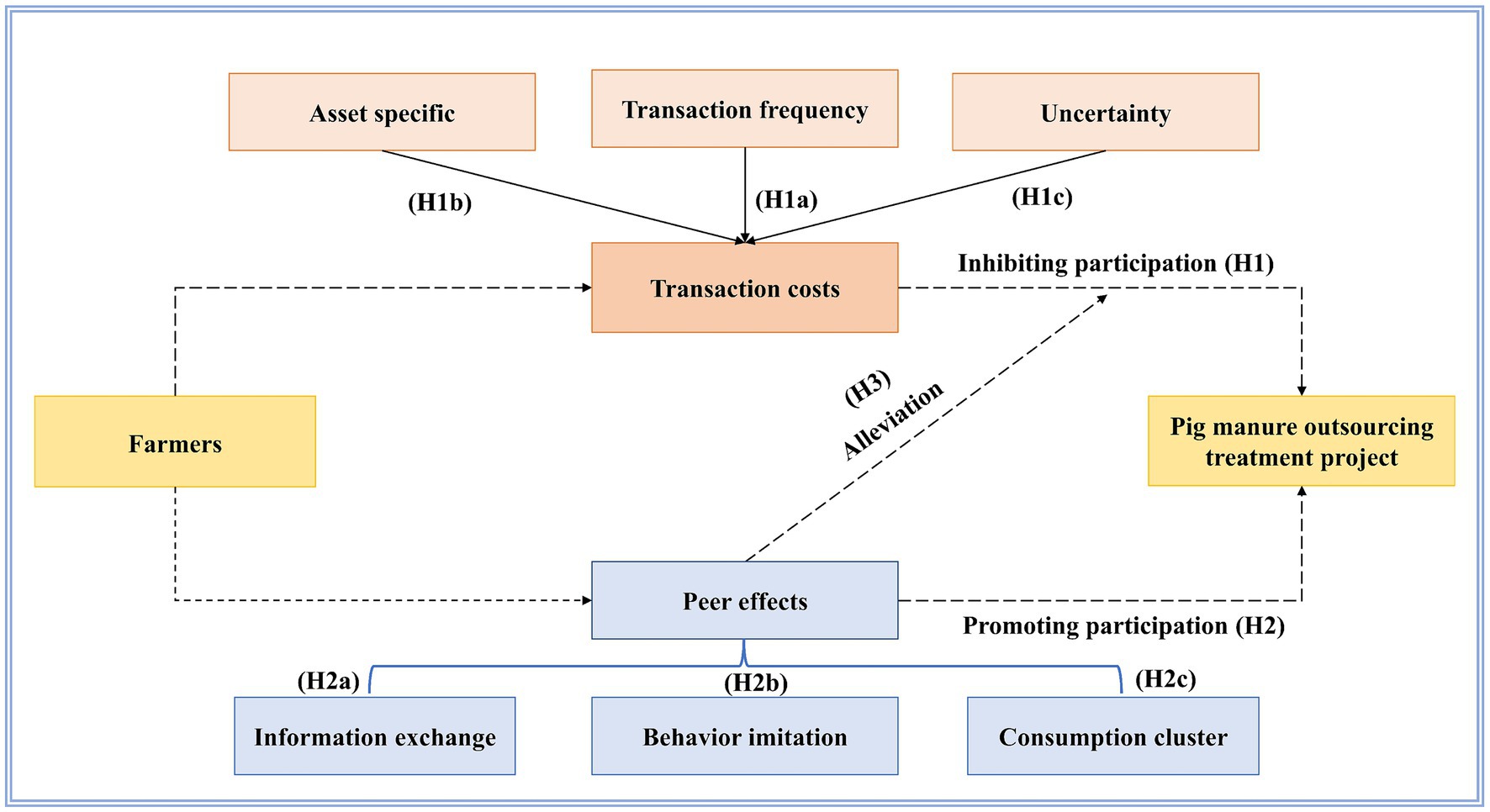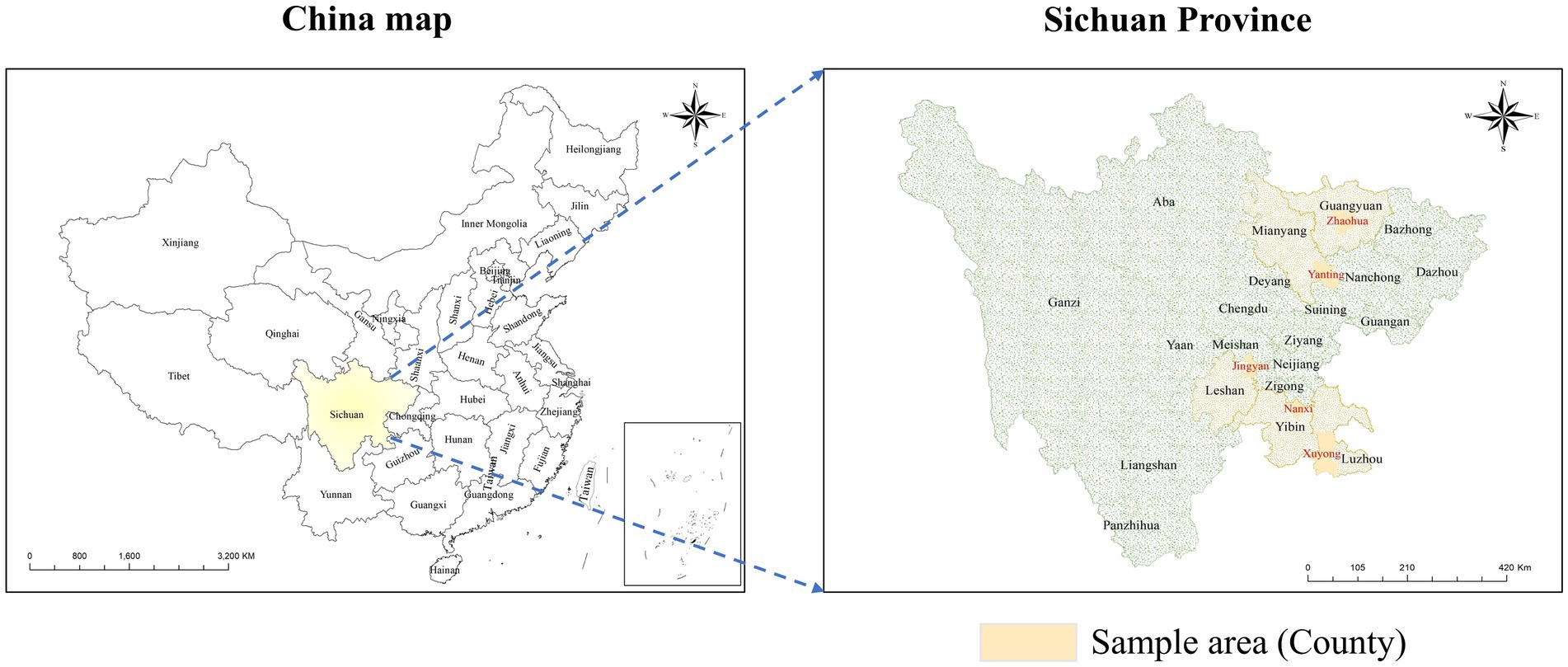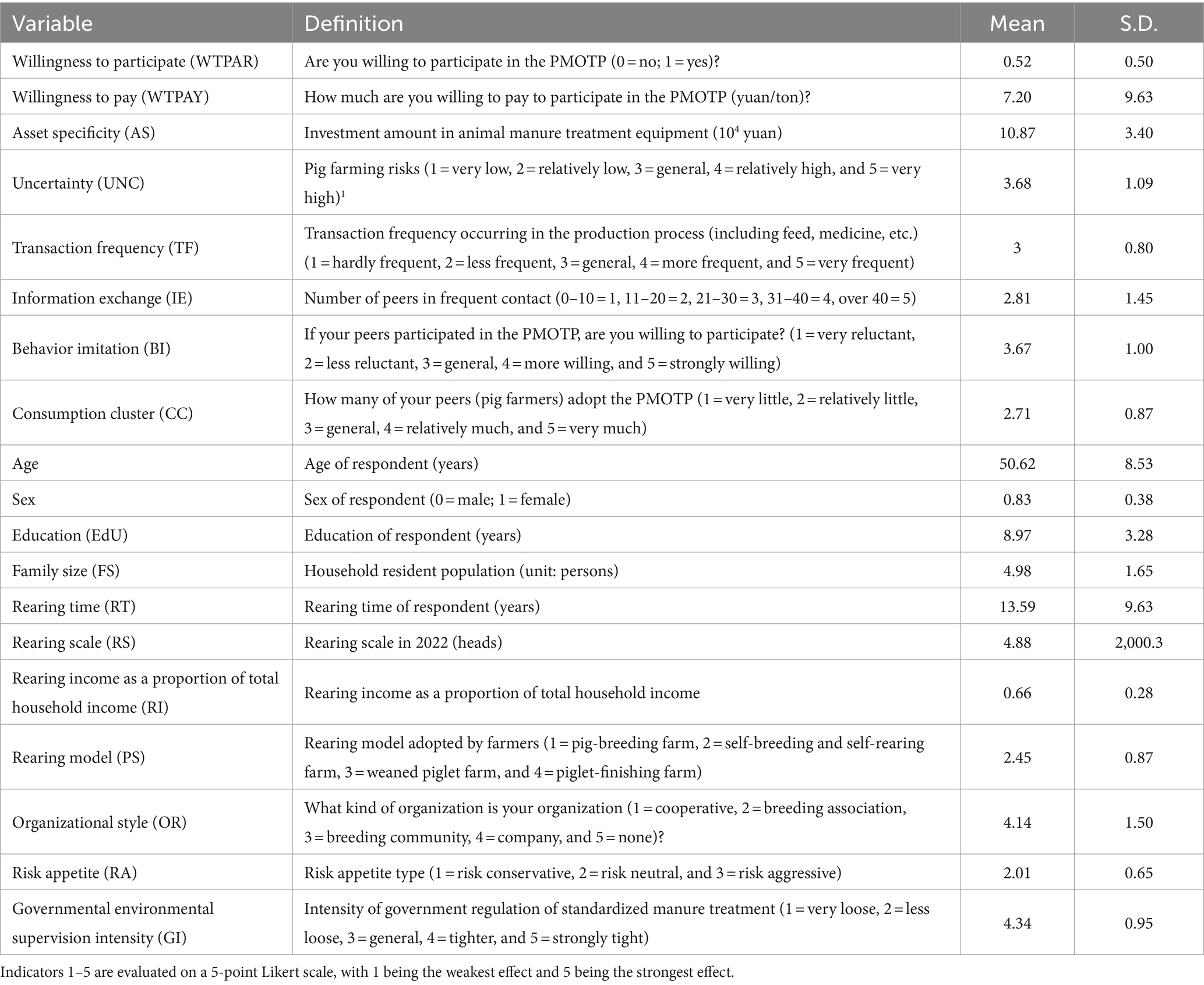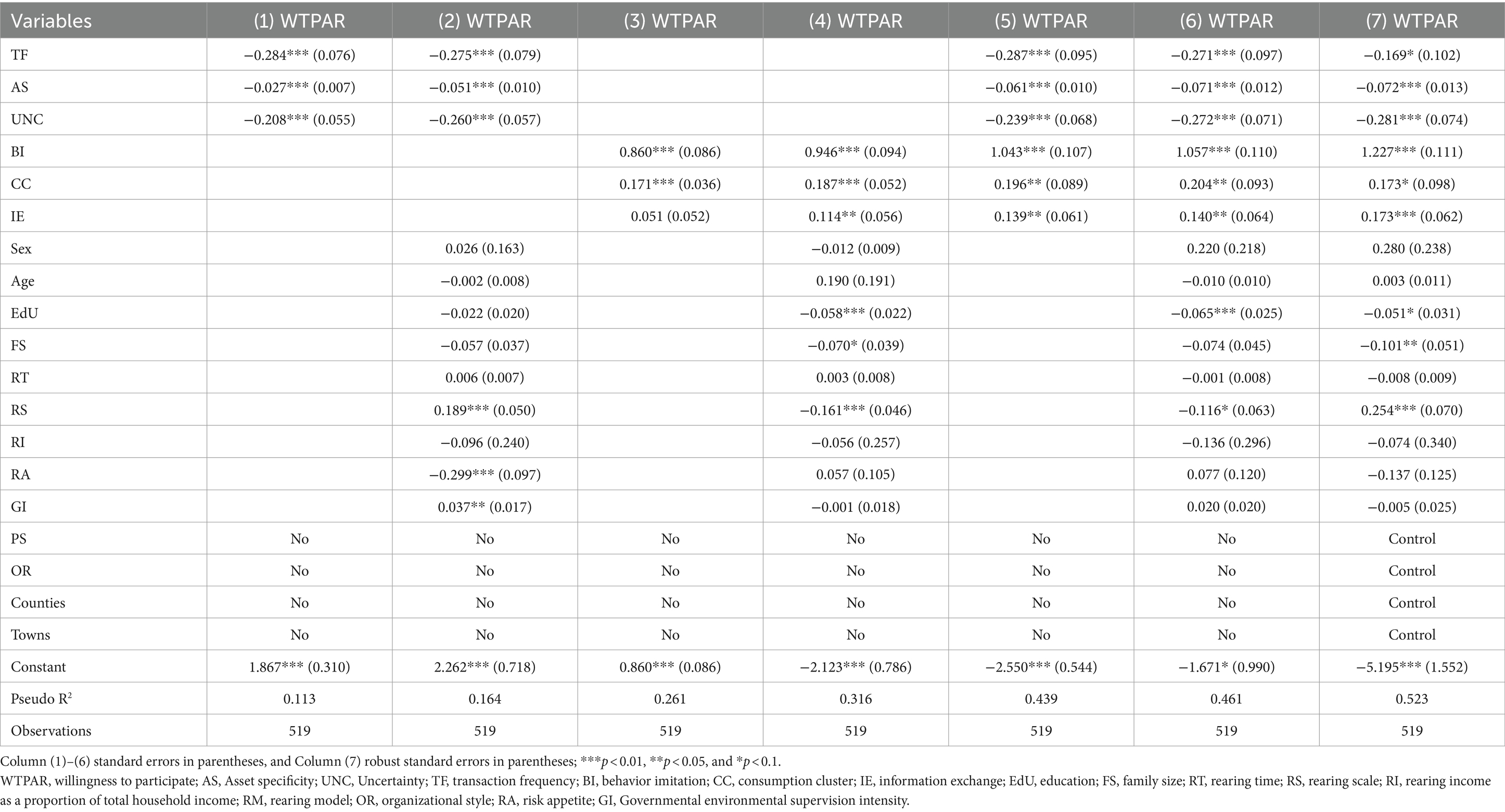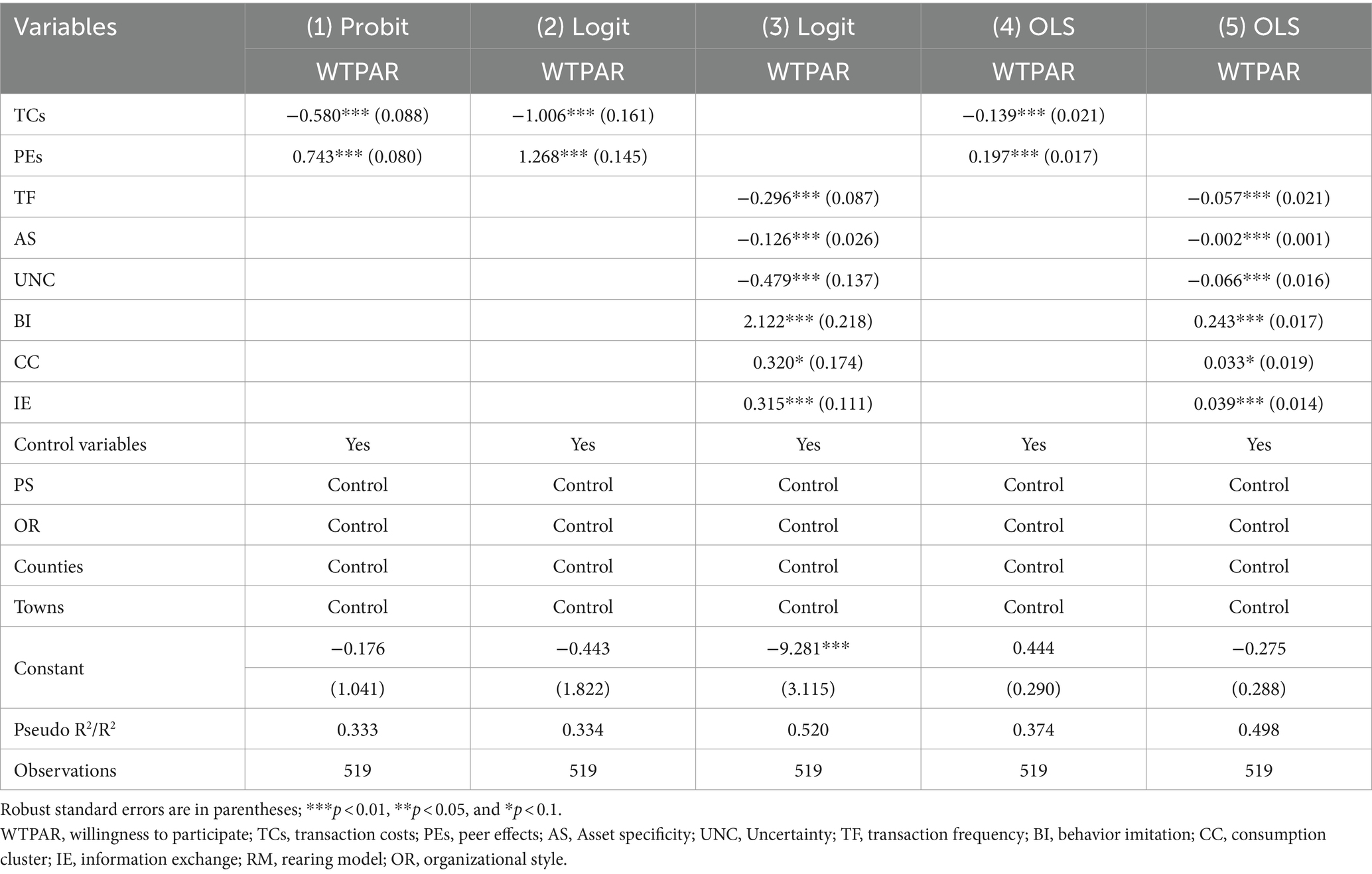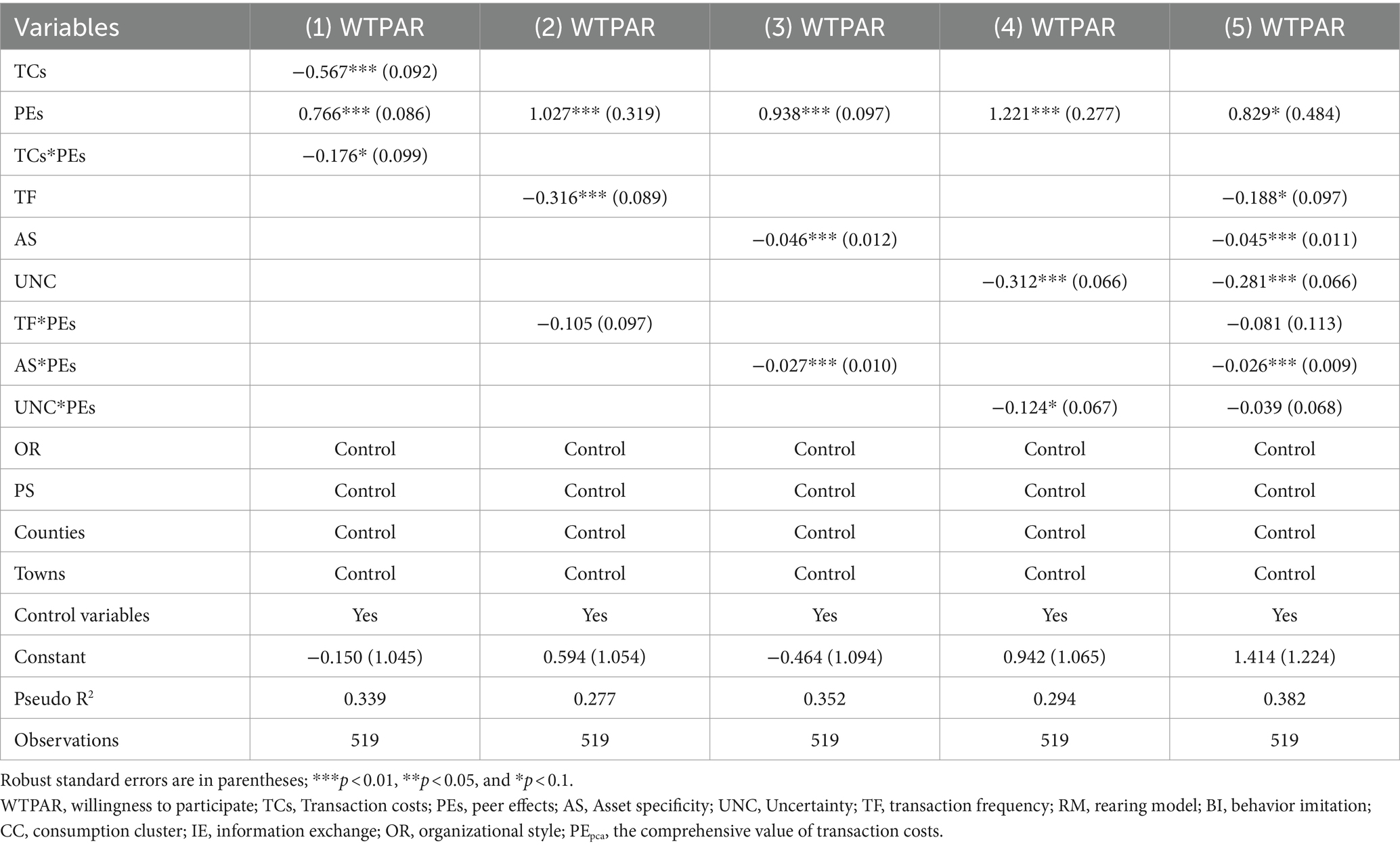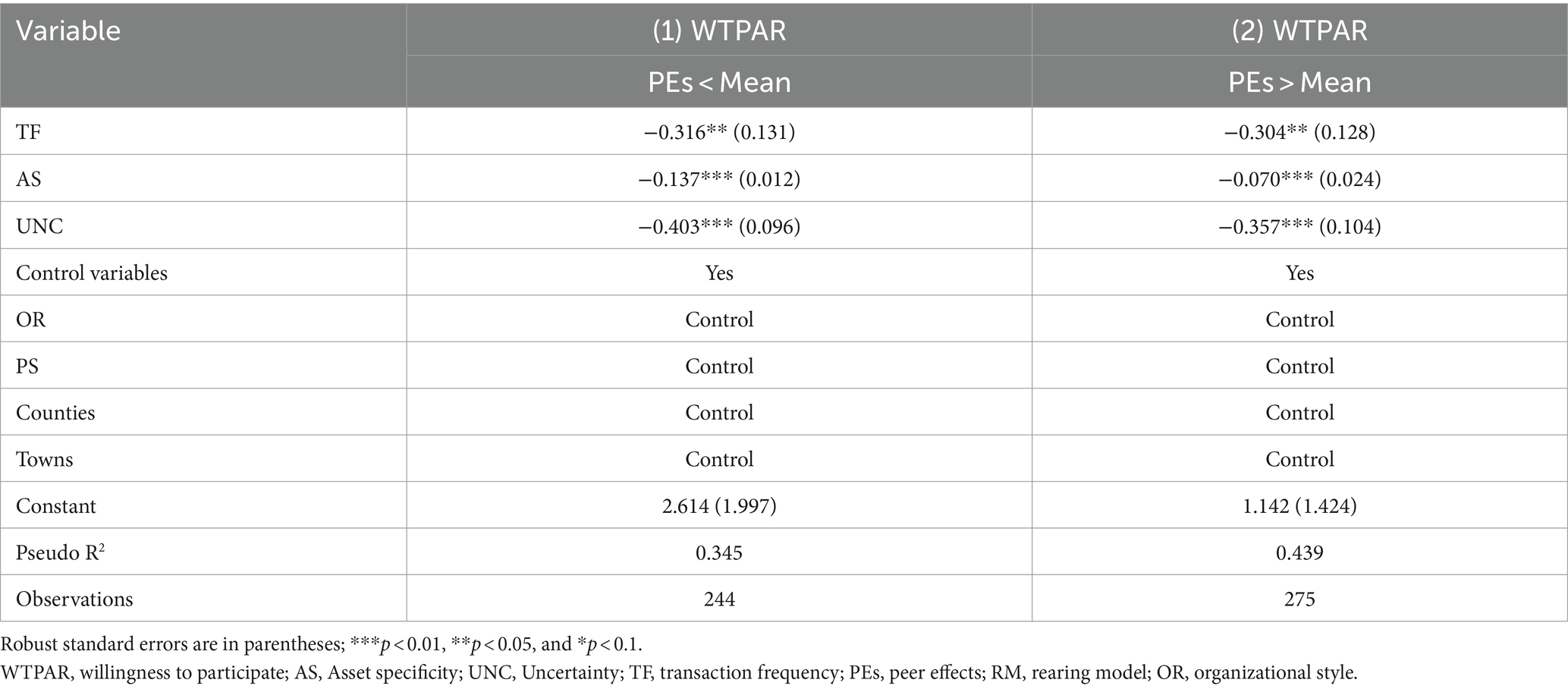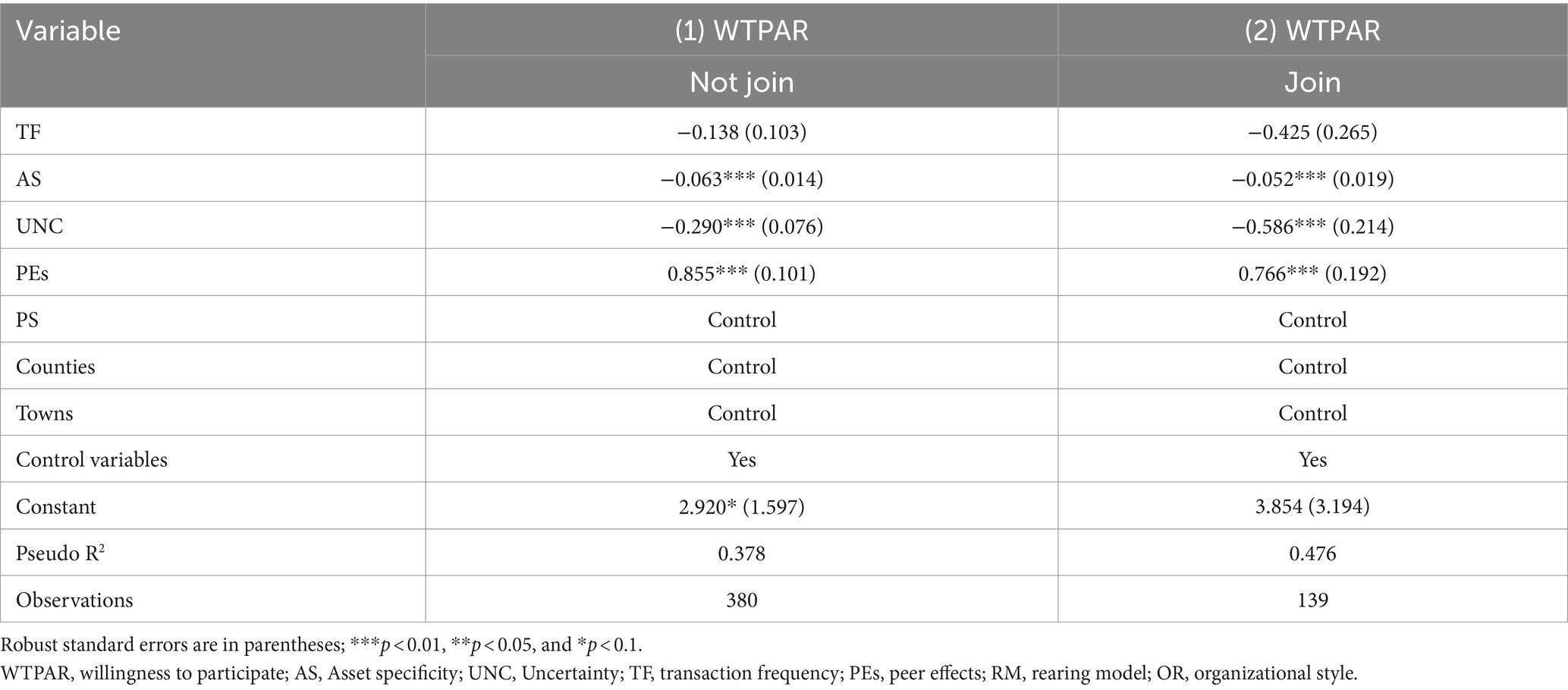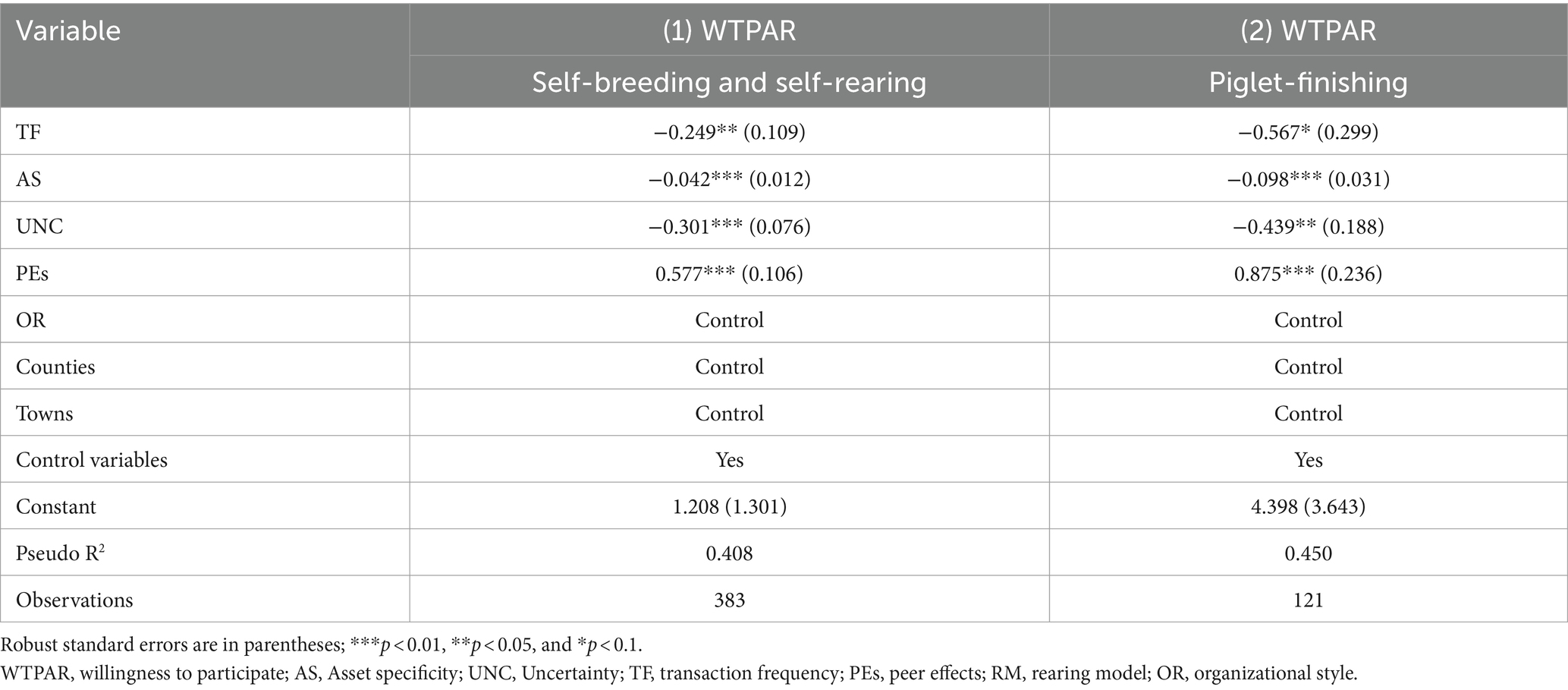- College of Management, Sichuan Agricultural University, Chengdu, China
This study aimed to explore the key factors affecting pig farmers’ willingness to participate in a pig manure outsourcing treatment project (PMOTP) from the perspectives of transaction costs and peer effects. Survey data from 512 pig farmers and the probit and Heckman probit models were used to estimate the impact of transaction costs and peer effects on farmers’ participation in the PMOTP. The results demonstrate that more than 62% of farmers are willing to participate in the PMOTP, and the average willingness to pay reaches 7.2 yuan/ton. Farmers’ willingness to participate in the PMOTP decreases with asset specificity, transaction frequency and uncertainty but increases with peer effects. Moreover, peer effects attenuate the inhibitory effect of transaction costs on farmers’ participation in the PMOTP. Heterogeneity analysis showed that large-scale farmers without the self-breeding and self-rearing model are more affected by transaction costs and peer effects than other farmers. Moreover, asset specificity and peer effects are likely to increase farmers’ willingness to pay for the project, which suggests that larger farms are more willing to invest in the PMOTP. These findings provide a useful reference for establishing a model for sustainable environmental service projects in the farming industry.
1 Introduction
The scale of pig farming in China is growing due to increasing consumer demand (Huong et al., 2014). China is the world’s largest pork producer, producing 55.41 million tons of pork in 2022 and accounting for 50% of the global pork production that year (Zhou et al., 2023). However, the manure and sewage produced during pig rearing cause considerable damage to soil, water and air (Shi et al., 2023). Some pig farmers have found it challenging to implement standardized treatment of livestock waste because of the need for more technology, funds and land, which has resulted in great damage to the ecological environment. In China, 37% of farms produce waste exceeding the maximum amount of animal waste that can be absorbed by farmland (Jin et al., 2020), and it is difficult to subject many small and medium-sized farmers to environmental supervision and enforce standardized treatment (Shi et al., 2023). Because of these factors, the environmental pollution problem of China’s pig farming industry is becoming increasingly serious, posing a severe threat to rural production and the living environment and restricting the modern development of the livestock industry.
Understanding how to effectively address pollution from livestock production is a global concern for sustainable agricultural development. Policymakers need to take measures to address environmental pollution from livestock production without negatively affecting farmer welfare (Sims and Alix-Garcia, 2017). Outsource services are tools that rely mainly on market mechanisms to encourage environmental protection (Sun et al., 2017). The implementation of outsource services requires at least one buyer and one seller of ecological services in the market, and transactions and services are carried out in accordance with the voluntary trading principle. To alleviate the pollution caused by pig farming, the Chinese government has introduced a pig manure outsourcing treatment project (PMOTP). The PMOTP operates through voluntary transactions under a “polluter pays, third-party treatment” model. PMOTP providers offer services such as manure collection, transport, treatment, and return to farmland, and the farmers who benefit from environmental services pay the service providers, essentially creating an environmental protection market (Hou et al., 2021).
The purpose of the PMOTP is to help farmers deal with pig manure through professional organization, reduce the farmers’ cost of pig manure treatment and improve the farm environment. However, although the Chinese government strongly supports the development of the PMOTP, it is very difficult to promote the application of such participation and payments. Economists believe that people have bounded rationality and that their behavior is influenced by both economic costs and social networks (Wang et al., 2021). In this way, farmers participating in the PMOTP consider not only the costs or benefits of participation but also social factors, such as the practices of their peers. The Chinese government has invested tens of billions of dollars to support the PMOTP to help farmers clean up their production environment. As the direct beneficiaries of the PMOTP, farmers’ active participation in the project is highly important for the long-term operation of environmental protection programs.
Outsource services are an effective way to address environmental externalities (Fan et al., 2022), and understanding participants’ behaviors helps improve the establishment of outsource service projects. First, the theory of planned behavior (TPB) can be applied to explain farmers’ environmental protection behavior. The TPB suggests that individuals should first be willing to participate in a specific behavior, and their willingness is affected by their attitude, subjective norms, and perceived behavioral control (Ajzen, 1991). The TPB has been applied in environmental conservation studies on water resources (Chai et al., 2021), saltmarshes (Muenzel and Martino, 2018), forests (Pagdee and Kawasaki, 2021) and biodiversity (Ingram et al., 2014). Second, some scholars have conducted such analyses from the perspective of costs and benefits. Neoclassical economic theory proposes that people are rational and that the ultimate goal of their behavior is to maximize their economic profits. Studies have shown that participation in outsource service projects can significantly increase participants’ income, but this effect varies across groups and can exacerbate income inequality (Sheng and Wang, 2022). Therefore, it is difficult to explain participant behavior from the perspective of expected benefits.
Scholars have also pointed out that human beings have bounded rationality. Simon (1955) argues that people struggle to obtain all the information they need to make decisions, so their behaviors are often not optimally useful. Tversky and Kahneman (1992) argue that people make decisions based on their knowledge, experiences, and circumstances, are influenced by their subjective feelings, and do not always have the goal of achieving economic optimality. Bounded rational behavior is often considered in the study of consumer behavior (Luo et al., 2023; Zhang Q. et al., 2023). However, although previous studies have provided some guidance for the promotion of outsource service projects, little attention has been given to outsource services in the livestock sector or to farmers’ participation in the PMOTP from the perspective of transaction cost theory and peer effects (PEs). Farmers have bounded rationality and oscillate between making perfectly rational and bounded rational decisions, and their behavior is constrained by a combination of economics and sociology. Therefore, considering the impact of transaction costs and PEs on farmers’ participation in the PMOTP is of great theoretical and practical significance.
This paper explores the key factors affecting farmers’ willingness to participate in the PMOTP from the perspective of transaction costs and PEs with the aim to provide theoretical support for the reasonable allocation of PMOTP costs and the construction of a payment mechanism for beneficiaries. It combines transaction cost theory and peer effects to construct an analytical framework for farmers’ participation in the PMOTP and uses survey data from 519 pig farmers from Sichuan Province, China, to explain the main driving mechanisms and disturbance factors of farmers’ participation. In addition, to better understand the factors influencing farmers’ willingness to participate in the PMOTP and their level of participation so that the government can better establish the environmental payment service project, we explore the influence of group heterogeneity and the level of payment on farmers’ participation in the PMOTP. The results of this study have important implications for the establishment of a model for sustainable payments for environmental protection services in the farming industry.
2 Theory and analytical framework
2.1 Transaction costs and the PMOTP
Transaction costs are a core factor determining whether a farmer participates in the PMOTP (Yao et al., 2022). Transaction costs are divided into ex ante and ex post transactions (Hautsch and Voigt, 2019). This paper takes farmers’ willingness to participate in the PMOTP, which occurs before a transaction, as an example and thus focuses on ex ante transaction cost theory. According to transaction cost theory (Williamson, 1989), when deciding whether to participate in the PMOTP, bounded rational farmers should first consider the transaction costs generated in the transaction (Coggan et al., 2010). Under the assumption of a given benefit from project participation, when transaction costs are high, farmers usually choose to treat the animal manure themselves, while when transaction costs are low, farmers choose to treat the manure with the help of services provided by the external market (Liu and Li, 2023). Drawing on the analytical ideas of Williamson’s transaction cost theory (Williamson, 1989), this paper analyses the impact of transaction costs on farmers’ participation in the PMOTP in terms of asset specificity, uncertainty and transaction frequency.
2.1.1 Asset specificity
Asset specificity refers to the characteristic of an asset that is difficult to use for other purposes after being adapted to a specific purpose (Williamson, 2010). Asset specificity locks assets into a particular use structure or nature (Bluemling and Wang, 2018). If a specific right of assets is separated and transferred, then in this case, pig farmers not only lose their overall right function but also bear higher transaction costs (Zhang X. et al., 2023). For example, pig farmers face higher costs for manure treatment equipment than do other types of farmers, and this strong asset specificity indicates a stronger trapping effect of pig manure treatment for these farmers, thus inhibiting their participation in the PMOTP.
2.1.2 Transaction frequency
Transaction frequency is an important part of transaction cost theory and an important factor affecting transaction costs (Williamson, 1989). In production, pig farmers need to buy many kinds of production materials (such as feed, vaccines, medicines, and disinfectants), and farmers likely connect with multiple transaction subjects or make frequent transactions when purchasing production materials. The higher transaction frequency than that associated with connecting to a single service subject results in higher transaction costs (Thomas and Vink, 2020). Therefore, when farmers have more frequent transactions, their transaction costs are relatively high (Sgroi and Sciancalepore, 2022), which may inhibit their participation in the PMOTP.
2.1.3 Uncertainty
The breeding industry often entails greater development risks than other industries (Taylor et al., 2020). In particular, the pig farming industry has been continuously impacted by risks, such as animal diseases, natural disasters and market fluctuations in the pig price (Xu et al., 2022). For example, African swine fever has had a severe impact on China’s farming industry, decreasing the country’s pig production by 30% in 2019 (Xu et al., 2022). To protect the safety of their animals, many farmers reduce their farms’ interactions with the outside world. When pig farmers need to transact with a party outside the farm, they will doubtlessly be exposed to greater risk. These risks lead to greater uncertainty regarding pig farmers’ production, operations and ability to participate in the PMOTP, with these farmers paying a high price to resist the impact of these risks. Natural disasters and market price uncertainty can also affect farmers’ production decision-making behavior. Because most farmers have poor risk aversion, they tend to choose conservative production methods in the face of high risks (Li et al., 2023). Therefore, this study proposes the following research hypotheses:
Hypothesis 1: Increased transaction costs are not conducive to farmers’ participation in the PMOTP.
Hypothesis 1a: Increased asset specificity has a restraining effect on farmers’ participation in the PMOTP.
Hypothesis 1b: A higher transaction frequency has a disincentive effect on farmers’ participation in the PMOTP.
Hypothesis 1b: Uncertainty has an inhibiting effect on farmers’ participation in the PMOTP.
2.2 PEs and the PMOTP
PEs, known as “herd effects” in psychology (Sacerdote, 2011), refer to situations in which, due to their bounded rationality, individuals cannot rely solely on their own information to make decisions and instead observe or learn from other individuals in the same region or industry (Eisenkopf, 2010). Behavioral economists believe that the “last mile” of people’s behavioral decision-making is affected by cognitive biases (Diener et al., 2003). We can refer to this notion as people’s behavior being affected by the costs of institutional change and information asymmetry (Chen et al., 2022; Ullah et al., 2020). Indeed, one of the prerequisites for the emergence of transactions is external economics, i.e., relying on external services to reduce production costs (Rindfleisch, 2020). However, information asymmetry creates an information gap between the consumer and the service provider. Especially in cases of information asymmetry, bounded rational individuals tend to overestimate the costs and risks of unknown behavioral decisions (Foramitti et al., 2021); thus, they prefer to maintain the status quo and choose options that are more familiar to them. Peer communication is a key channel through which farmers can obtain information and is an important reference for farmers in adopting particular behaviors (Yuan et al., 2021). Farmers tend to choose the same behaviors as their peers, especially when most of their peers choose a particular behavior due to the herd mentality (Ali-Rind et al., 2023).
The core of PEs is that human beings are both “economic” and “social.” The behaviors of individuals are influenced by market economic factors and other peers (Sacerdote, 2011). Combining sociological and economic (Palm, 2017), there are three main aspects of PEs that can drive farmers to participate in the PMOTP. (1) Information exchange. PEs based on geographic proximity and kinship can reduce farmers’ information-seeking costs, as the technological understanding transferred from peers is based on their own production experience and local conditions, which farmers find easier to understand and accept (Niu et al., 2022). For example, Zhang et al. (2022) found that due to the lack of communication channels with peers, farmers show hesitation in implementing government policies and green production. Thus, this aspect of PEs also helps farmers understand the PMOTP and reduces the risk expectation and uncertainty of participation. (2) Behavior imitation. The risks and costs of making innovation decisions independently are relatively high; thus, farmers may tend to overestimate expected risks and costs when weighing costs and benefits (Tran-Nam and Tiet, 2022). However, when other farmers participate in the PMOTP, farmers can directly observe the benefits and effectiveness of participation, as “seeing is believing,” thus stimulating farmers’ preference and significantly improving their assessment of the costs and benefits of participation (Li and Fang, 2022). On the other hand, peer farmers usually have similar resource endowments and social structure relationships, their behaviors align with their technical needs, and imitating each other’s successful behaviors brings about a sense of security in behavioral decision-making; all of these aspects can change farmers’ value judgment and prompt them to participate in the PMOTP (Zant, 2023). (3) Consumption cluster. Peer effects give rise to consumption agglomeration effects, which reduce transaction costs for farmers participating in the PMOTP (Gao et al., 2023). That is, farmers’ consistent participation grants them higher levels of bargaining and negotiation power (Zant, 2023). When farmers produce consumption agglomeration effects, PMOTP providers may also choose to gather in areas with apparent consumption agglomeration because the transportation, time, and search costs can be reduced; this, in turn, attracts more farmers to participate. Therefore, Hypotheses 2 and 3 are proposed. The theoretical research framework of this paper is presented below (Figure 1).
Hypothesis 2: Positive PEs can promote farmers’ willingness to participate in the PMOTP.
Hypothesis 2a: Increased information exchange can promote farmers’ willingness to participate in the PMOTP.
Hypothesis 2b: Positive Behavior imitation can promote farmers’ willingness to participate in the PMOTP.
Hypothesis 2c: Greater consumption clustering can promote farmers’ willingness to participate in the PMOTP.
Hypothesis 3: PEs can influence farmers’ willingness to participate in the PMOTP by adjusting transaction costs.
3 Data source, variable selection, and research method
3.1 Data source
The research data came from a questionnaire survey of pig farmers in Sichuan Province, China. Sichuan Province is the largest pig-producing province in China, with its pig production volume ranking first among all provinces in China, reaching 63.14 and 65.48 million head in 2021 and 2022, respectively (NBS, 2023). Pig farmers are becoming increasingly concentrated in Sichuan Province; thus, this setting is typical and representative of pig farming (Li et al., 2023). We selected Jingyan County, Xuyong County, Nanxi District, Zhaohua District, and Yanting County in accordance with their volume of pig farming and representative socioeconomic development characteristics, and we randomly selected 4–5 towns and 20–25 farmers in each county. The research method involved one-on-one household interviews. We sent out a total of 550 survey questionnaires. After screening and eliminating questionnaires missing important information or having inconsistent data, 519 valid questionnaires were obtained. A map of the survey sample locations is shown in Figure 2.
3.2 Variable selection
3.2.1 Dependent variable
The primary dependent variable of this study is farmers’ willingness to participate in the PMOTP, expressed by their answer to the question “Are you willing to participate in the PMOTP?” Furthermore, we examined the farmers’ willingness to pay for the PMOTP.
3.2.2 Independent variables
The core independent variables in this study are transaction costs and PEs. According to the definition of transaction costs (Rindfleisch, 2020; Williamson, 2010), ex ante transaction costs include mainly asset specificity, transaction frequency and uncertainty. In this paper, the amount invested in animal manure treatment equipment is used to measure asset specificity, and the transaction frequency occurring in the production process (including feed, medicine, etc.) and current pig-rearing risk are used to measure uncertainty. The peer effects in this paper came from three aspects: information exchange, behavior imitation and consumption cluster. “Number of peers in frequent contact” to represent information exchange; “If your peers participated in the PMOTP, are you willing to participate?” to represent behavior imitation; “how many of your peers adopt the PMOTP” to represent consumption cluster.
3.2.3 Control variables
To alleviate the problem of omitted variable bias, this study controls for individual, household, and production and business characteristics. Individual characteristics include mainly gender, age, education level, and risk preference (He et al., 2022); family characteristics include mainly the number of family members and the amount of income (Li et al., 2023); production and business characteristics include the number of rearing years, rearing scale, type of farming, and type of organization (Huong et al., 2020); and other variables include the intensity of governmental environmental supervision (Zhou et al., 2022). Table 1 shows the definitions of the variables.
Approximately 52% of the farmers were willing to participate in the PMOTP, with an average payment level of 7.2 yuan/ton (Table 1). Among the farmers in the sample, the ratio of male farmers to female farmers was approximately 8.3:1.7, the average farmer age was 50.62 years, the average time spent breeding was 13.59 years, and the average breeding scale was 728 heads. Most pig farmers were risk neutral and believe that the government’s environmental supervision intensity is relatively strict (4.34), indicating that the current environmental pressure placed on farmers is burdensome. These farmers presented similar characteristics and structures to those of the pig farmers surveyed by Li et al. (2023) in Sichuan Province, China, which supports the bounded rationality of the samples to a certain extent.
Among the transaction costs, the average value of farmers’ asset specificity reached 108,700 yuan, and the values of uncertainty and transaction frequency reached 3.68 and 3, respectively. The value of 2.71 obtained to measure the consumption cluster indicates that only a few peers have adopted PMOTP. Most farmers indicated they would be willing to participate in the PMOTP program if their peers participated.
3.3 Research methods
3.3.1 Probit model
This paper focuses first on farmers’ willingness to participate in the PMOTP, using the dichotomous response variables of whether farmers are willing or unwilling to participate. Therefore, a probit model is used to analyze farmers’ willingness to participate in the PMOTP, and the probit mode can be expressed as Equation (1):
where denotes the farmers’ willingness to participate in the PMOTP and is a standard normal cumulative distribution function; are independent variables; and are coefficients.
3.3.2 Heckman probit model
Furthermore, we wanted to analyze the farmers’ willingness to pay. Farmers’ participation in the PMOTP is divided into two stages: the first stage involved choosing one of two options (willingness or unwillingness to participate), and the second stage involved the level of payment (willingness or unwillingness to pay). The level of payments from this group of farmers could be observed only if they were willing to participate in the PMOTP. To achieve this goal, we required two steps: the willingness to participate and the willingness to pay. We assumed that farmers were willing to pay for PMOPT because they are willing to participate in the program; if farmers were not willing to participate in PMOTP, they would not pay for the program. Meanwhile, farmers’ participation in the PMOTP is highly autonomous, and unobservable factors can have an impact on participation behavior. However, using only farmers participating in the PMOTP as a sample would produce biased estimates, i.e., sample selection bias.
The Heckman model can correct such sample selection bias through a two-stage estimate (Yarbaşı and Çelik, 2023). Therefore, we used the Heckman Probit model to analyze the payment decision-making behavior of farmers and solve the problem of sample selection bias. Referencing Heckman (1979), a probit model was used in the first stage to estimate the entire sample via the following Equation (2):
where is the probability of farmers being willing to participate in the PMOTP, is a latent variable that represents participation, is an independent variable, is a coefficient, and is a random error term.
In the second stage, ordinary least squares (OLS) regression was used to correct the sample selection bias problem and obtain consistent estimates (Yarbaşı and Çelik, 2023) via the following Equation (3):
where is the payment level at which farmers are willing to participate in the PMOTP, is the independent variable, is the coefficient, is the coefficient of the inverse Mill’s ratio, is the estimated value obtained from and is the random error term.
4 Results
4.1 Effect of transaction costs and PEs on farmers’ participation in the PMOTP
4.1.1 Benchmark regression
Table 2 shows the benchmark regression results. Column (1) of Table 2 includes only the three indicators denoting transaction costs, while Column (2) includes all the control variables in the regression model. Columns (3) and (4) of Table 2 show the results of the stepwise regression of PEs on farmers’ willingness to participate in the PMOTP. Column (5) to (7) shows the combined effect of transaction costs and PEs on farmers’ willingness to participate in the PMOTP. As shown in Column (7) Table 2, transaction frequency, asset specificity and uncertainty are significantly negative at the 1% level, which fully supports Hypothesis 1 (a, b, and c) and is similar to the results of Hou et al. (2023). This finding suggests that the increase in farmers’ transaction costs during the operation of the PMOTP is not conducive to farmers’ participation in the project. In contrast, PEs have a significant promoting effect. Among them, information exchange and behavior imitation promote the farmers’ participation in the PMOTP at the significance level of 1%, and consumption cluster also has an incentive role on farmers’ willingness to participate at the significance level of 10%. That is, when most of their peers participate in the PMOTP, respondents also show willingness to participate. Hypothesis 2 (a, b, c) was confirmed.
Control variables, the greater the share of rearing income in total household income is, the less likely the farmer is to participate in the PMOTP. However, uncertainty exists in the regression results for the rearing scale. When the rearing mode and organizational style are controlled, farmers’ risk preference and rearing scale have opposite effects on their willingness to participate in the PMOTP, which indicates that the effects of farmers’ risk preference and rearing scale may vary across different rearing modes or organizational styles. The specific roles of farmers’ organizational style, rearing model and rearing scale were analyzed via a heterogeneity test.
4.1.2 Robustness test
In the benchmark regression (Section 4.1.1), we controlled for different types of rearing models, organizational styles, counties and towns and conduct robust standard error regression, which enhances the accuracy of the regression model. We changed the model and main explanatory variables to further ensure the correctness of the regression results. First, we combined the variables of three dimensions—asset specificity, uncertainty and transaction frequency—through principal component analysis (PCA) and used a probit model for regression. Similarly, the PCA method was also used to calculate the comprehensive value of PEs. The regression results are shown in Column (1) of Table 3. The coefficient of transaction costs (TCs) is significantly negative (−0.580), and PEs are positive (0.743) and significant at the 1% level, which is consistent with the benchmark regression results.
Second, we used logit and OLS models to estimate the impact of transaction costs and PEs on farmers’ willingness to participate in the PMOTP. Like probit models, logit models can also handle binary variables from cross-sectional data, and OLS regression is a common method used to verify linear relationships between variables. Columns (2) and (4) of Table 4 show that the sign direction of the coefficients of transaction costs and PEs does not change after OLS and Logit regression methods are adopted, and the p-value is less than 0.01. As shown in Columns (3) and (5) of Table 3, the transaction cost dimensions still have a significant negative impact on farmers’ participation in the PMOTP (p < 0.01), while PEs dimensions maintain a positive role according to the logit and OLS approaches. In the results from the whole regression, we adopted the robust standard error regression method and control for the county and township, which can effectively improve the reliability of the regression results. By verifying via different methods, we still obtained results similar to those in Section 4.1.1, which indicates that the models and methods adopted are effective and reliable.
4.2 Moderating role of PEs
PEs can affect the behavioral choices of farmers, but in the context of high transaction costs, do PEs play a positive or negative moderating role? In fact, farmers can obtain more information about the PMOTP by talking to their peers, which can affect their assessment of the value of participating in the project. Assuming that PEs can increase farmers’ perceptions of the benefits of PMOTP participation, PEs can mitigate the adverse effects of transaction costs.
To verify this hypothesis, we first used the comprehensive index of transaction costs (TCs) and PEs (PEs) for interaction processing and conduct a regression. Moreover, to prevent possible collinearity of the interaction term, we decentralized the main variables. The results are shown in Table 4, Column (1). The interaction term TCs*PEs is not positive, indicating that PEs have a dampening effect on the role of transaction costs at 10% significance level.
Furthermore, we interacted transaction frequency, asset specificity and uncertainty with PEs and conducted regressions to verify the role of these interaction terms in farmers’ participation in the PMOTP. The results, presented in Columns (2)–(5) of Table 4, show that only the AS*PEs coefficient is significantly negative (p < 0.01); i.e., PEs significantly weaken the negative effect of asset specificity. Additionally, the coefficients of the interaction terms UNC*PEs in Columns (4), respectively, are negative at 10% significance level. The coefficients of TF*PEs are negative but nonsignificant, indicating that PEs may inhibit transaction risk, but further tests are needed for verification. Therefore, following Otieno et al. (2023), we attempted to further analyze the moderating role of PEs through the use of grouped regression. We used the mean value of PEs as the basis for grouping. From Table 5, the negative effects of transaction frequency, risk and asset specificity on farmers’ willingness to participate in PMOTP in the high-mean group (Column 2) are significantly weaker than the effects in the low-mean group (Column 1), which indicates that positive PEs can weaken the negative effects of transaction costs on farmers’ willingness to participate in the PMOTP.
4.3 Heterogeneity analysis
4.3.1 Effect of the decision to join a cooperative organization on farmers’ willingness to participate in the PMOTP
We further verified the effect of farmers’ decision to join a cooperative organization on their participation in the PMOTP. Table 6 shows that farmers who do not join an organization are greatly affected by transaction costs and PEs (Columns 1 and 2). For example, asset specificity and uncertainty have stronger negative effects on PMOTP participation for farmers who are not involved in any cooperative than for farmers who are involved in at least one cooperative. A similar result is shown for PEs. Farmers not involved in any cooperative are more affected by PEs than those involved in at least one cooperative. Notably, in the process of heterogeneity analysis, we adopted a fixed effects model and conduct robust standard error regression; thus, the results are reliable.
4.3.2 Impact of different rearing modes on farmers’ willingness to participate in the PMOTP
The main pig-rearing modes in China are self-breeding and self-rearing, pig-breeding, piglet-finishing and weaned piglet-selling farms. However, according to our survey results, the main pig-rearing modes in Sichuan Province are self-breeding and self-rearing farms and piglet-finishing farms,1 while pig-breeding farms and weaned piglet-selling farms are rare. Thus, we analyze only self-breeding and self-rearing farms and piglet-finishing farms. As shown in Table 7, farmers adopting the piglet-finishing model are generally more affected by transaction costs and PEs, while those adopting the self-breeding and self-rearing model are less affected. Generally, self-breeding and self-rearing farms are small and medium-sized farms, while piglet-finishing farms are larger (Li et al., 2023), which means that piglet-finishing farmers purchase more materials during production than self-breeding and self-rearing farmers, and their total value of equipment assets is greater. This situation may expose piglet-finishing farms to greater risks, resulting in this group of farmers being more sensitive to transaction costs than other groups of farmers are. Therefore, as the transaction frequency, asset specificity and uncertainty increase, the probability of piglet-finishing farmers participating in the PMOTP decreases.
4.3.3 Role of the rearing scale in farmers’ participation in the PMOTP
Referring to Zhou et al. (2023), we defined farmers with fewer than 50 pigs per year as free-range (small-scale) farmers, farmers with 50 to 500 pigs per year as medium-scale farmers, and farmers with more than 500 pigs per year as large-scale farmers.
Table 8 shows that the impact of transaction frequency on small-scale farmers’ participation in the PMOTP is not significant and that the effect on medium-and large-scale farmers is more pronounced. Asset specificity has a negative effect on medium-and large-scale farmers but a positive effect on small-scale farmers. Uncertainty has a disincentive effect on the participation of small-and medium-scale farmers in the PMOTP, but the effect is not significant for large-scale farmers. PEs have a positive effect on small-and medium-scale farmers’ participation in the PMOTP, but the effect of PEs on large-scale farmers is not significant.
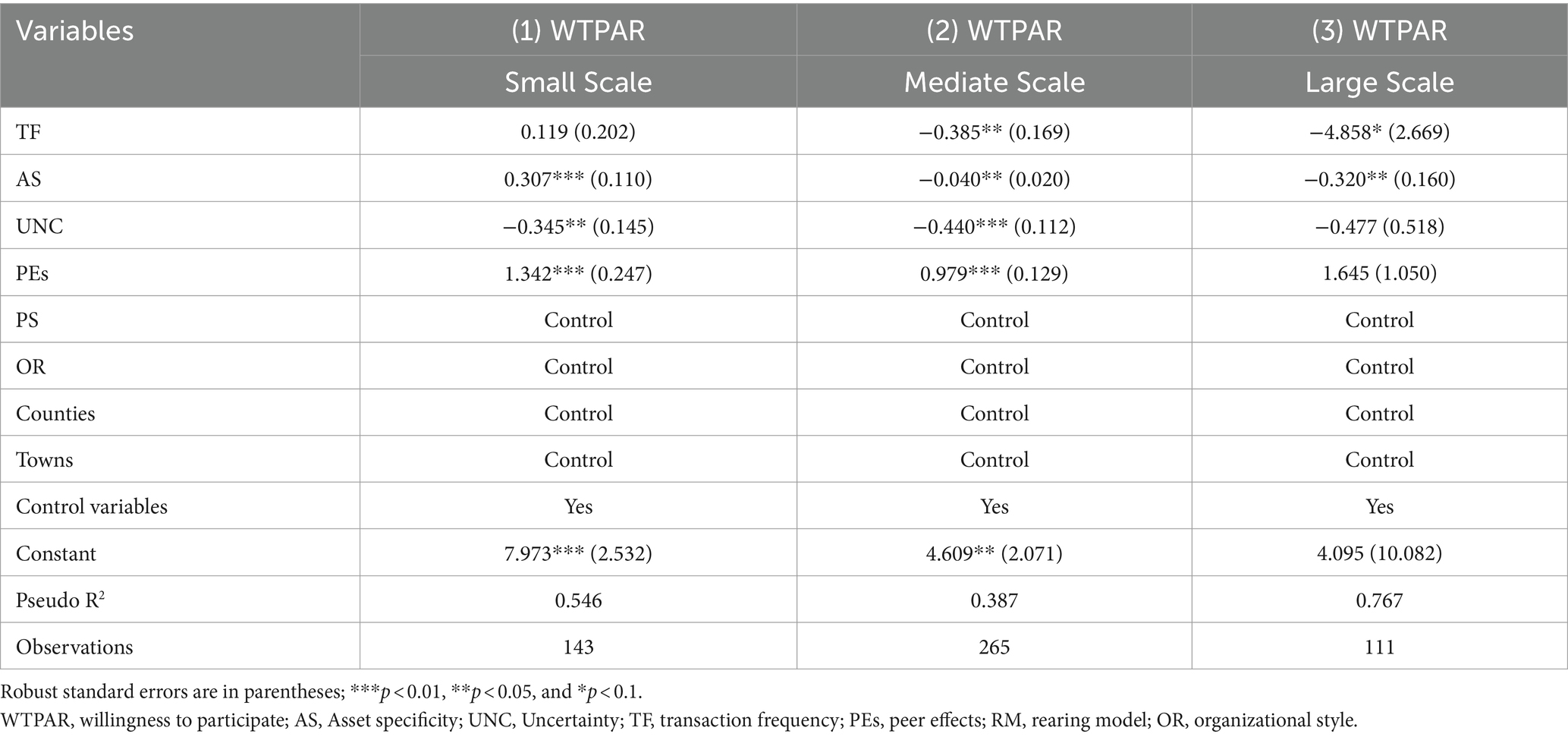
Table 8. Role of the rearing scale in farmers’ willingness to participate in manure recycling projects.
Depending on the actual situation, small-scale farmers generally follow self-breeding and self-rearing models; therefore, these farmers have less frequent transactions than other farmers. As the scale of rearing increases, the purchase of feed, drugs, and disinfectants for epidemic prevention becomes more frequent, thus increasing transaction costs. Large-scale farming can reduce production costs and allow farmers to resist risks through the advantages of modern operation and involves optimal manure treatment equipment, which leads to higher transaction costs, such that the behaviors of their peers have little impact on these farmers.
4.4 Further analysis: impact of transaction costs and PEs on farmers’ payment levels
After exploring the influence of farmers’ willingness to participate in the PMOTP, we further examined farmers’ willingness to pay for such participation, which is helpful for establishing an effective environmental payment service mechanism for livestock (Ren, 2022). The Heckman probit model was used to analyze the effects of transaction costs and PEs on farmers’ payment levels. In Column (1) of Table 9, asset specificity, transaction frequent, and risk are shown to have a significantly negative effect on farmers’ willingness to participate, and PEs are positive. As Column (2) of Table 9 shows, the higher the transaction frequency and risk levels are, the less the farmers are willing to pay to participate in the PMOTP; when PEs are more significant, farmers are willing to pay more to participate in the PMOTP. Moreover, farmers with more manure treatment equipment assets tend to be willing to pay more to participate in such projects than those with fewer such assets.
5 Discussion
This study aimed to assess the effectiveness of the current PMOTP in China from the perspective of farmers’ willingness to participate. Therefore, we established an analytical framework of farmers’ willingness to participate in the PMOTP based on transaction cost theory and PE theory and conduct an empirical analysis using survey data from 519 pig farmers. In addition, to better understand the factors influencing farmers’ willingness to participate in the PMOTP and their level of participation so that the government can better establish an environmental payment service project, we explored the influence of group heterogeneity and the level of payment on farmers’ participation in the PMOTP. The results indicate that farmers are strongly willing to participate, which is somewhat different from the findings of Zhao et al. (2019). While Zhao et al.’s study revealed that farmers’ willingness to participate in the PMOTP (41%) and level of payment (4.6 yuan, on average) were low, our study obtained somewhat different results (52.6% and 7.2 yuan, respectively). There are several reasons for this result. (1) As the Chinese government has strengthened its efforts to control the environment, environmental protection has become a bottom line for farmers (Bai et al., 2022). The government inspects farms for environmental problems at least 3–5 times per year, which raises the levels of environmental awareness and places higher pressure on farmers (Li et al., 2023). If a farm is found to have failed to comply with the standards of manure treatment or even to have discharged manure clandestinely, the farmer is fined (0–50,000 yuan) and may even face farm closure or jail time due to environmental concerns (Pan, 2023). Farmers participate in the PMOTP as long as they can guarantee the good environmental status of their farms. (2) The cost of PMOTP participation can vary significantly depending on external factors, such as transport distance. In addition, the survey used in this study took place in 2023, and compared with the data of Zhao et al.’s survey in 2019, price increases are an important factor that must be considered. All of the above factors can lead to differences in farmers’ willingness to participate and their payment levels.
Our study also further confirms the role of transaction cost theory and peer effects in PMOTP participation. Although farmers are strongly willing to participate in the PMOTP, transaction costs are an important factor inhibiting them. In fact, the Chinese government emphasizes that farmers should invest in environmental treatment equipment (Bai et al., 2019), which can increase the transaction costs of farmers participating in the PMOTP and create a conflict in the promotion of these projects. Therefore, how to reduce the transaction costs of farmers adopting PMOTP is the key to promote environmental protection projects (Coggan et al., 2010; Palm, 2017). Peer participation and support are important factors that motivate farmers to participate in the PMOTP. Furthermore, PEs reduce the inhibitory effect of transaction costs on farmers’ PMOTP participation, and the “information exchange,” “behavior imitation,” and “consumption cluster” are verified. A large amount of sociological literature also supports this assertion, and the role of PEs have been verified in schools, enterprises and factories (Ali-Rind et al., 2023).
Heterogeneity analyses show that large-scale farmers are more significantly affected by transaction costs and PEs than are other types of farmers. In China, the number of large-scale farms continues to increase, which has also led to stricter government regulation of these farms. To ease the pressure of environmental regulation, large-scale farms tend to pay more attention to market information and methods of handling livestock manure, and they are willing to adopt new methods suggested by their peers (Zhou et al., 2024). Our further analyses reveal that although a higher degree of asset specificity is associated with a lower willingness of farmers to participate in the PMOTP, it is conducive to increasing the level of farmer payments, although this phenomenon still deserves further investigation. This result shows that transaction costs have two effects on farmers’ adoption of new technologies: on the one hand, transaction costs will reduce the willingness and behavior of some farmers to adopt new methods; on the other hand, farmers with high asset specificity have better capital to adopt new technologies than those with low asset specificity.
6 Research conclusions and policy recommendations
This paper adopts the traditional probit model and Heckman probit model and uses research data from 519 pig farmers in Sichuan Province to analyze the impact of transaction costs and peer effects on farmers’ participation in the PMOTP. The main conclusions are as follows. (1) Farmers’ willingness to participate in the PMOTP decreases with asset specificity, transaction frequency and uncertainty but increases with PEs. (2) The inhibitory effect of transaction costs on farmers’ willingness to participate in the PMOTP is weakened by PEs. (3) Heterogeneity analyses show that nonparticipating farmers, self-breeding and self-rearing farmers, and large-scale farmers are more significantly affected by transaction costs and PEs. (4) Increased transaction frequency and uncertainty can reduce farmers’ willingness to pay for PMOTP participation, but asset specificity and PEs are likely to facilitate increased farmer investment in the PMOTP.
Based on the above conclusions, this paper offers the following policy implications. First, transaction costs have a significant inhibitory effect on farmers’ participation in the PMOTP. Therefore, the transaction time, transaction frequency and transaction method should be reasonably arranged to reduce farmers’ information search costs and transaction costs, the transaction contract should be standardized, and farmers should cooperate with the government as a guarantor to reduce the degree of transaction risk. Second, by exploiting collective consumption, cooperatives, farming associations or village collective organizations can unify their negotiations with PMOTP providers and reduce transaction costs by leveraging scale advantages and competitiveness. Finally, large-scale farmers have shown sufficient willingness to adopt PMOTP, so the government should also subsidize this project and encourage large-scale farmers to adopt PMOTP. The number of large-scale farmers is increasing in China, and these farmers can play a better demonstration role and peer effects.
Data availability statement
The data analyzed in this study is subject to the following licenses/restrictions: the data that support the findings of this study are available from the corresponding author [JL], upon reasonable request. Requests to access these datasets should be directed to TGpxOTgwMUAxMjYuY29t.
Ethics statement
Ethical review and approval was not required for the study on human participants in accordance with the local legislation and institutional requirements. Written informed consent from the [patients/participants OR patients/participants legal guardian/next of kin] was not required to participate in this study in accordance with the national legislation and the institutional requirements.
Author contributions
KZ: Conceptualization, Data curation, Formal analysis, Investigation, Methodology, Project administration, Software, Visualization, Writing – original draft, Writing – review & editing. HW: Funding acquisition, Writing – review & editing, Supervision. ZZ: Conceptualization, Data curation, Methodology, Writing – review & editing. JL: Conceptualization, Funding acquisition, Writing – review & editing, Supervision.
Funding
The author(s) declare that financial support was received for the research, authorship, and/or publication of this article. This work was supported by the National Nature Science Foundation of China [72103152] and Sichuan Provincial Social Science Planning Project [SC19B084].
Acknowledgments
Thanks to the editors and reviewers for their suggestions.
Conflict of interest
The authors declare that the research was conducted in the absence of any commercial or financial relationships that could be construed as a potential conflict of interest.
Publisher’s note
All claims expressed in this article are solely those of the authors and do not necessarily represent those of their affiliated organizations, or those of the publisher, the editors and the reviewers. Any product that may be evaluated in this article, or claim that may be made by its manufacturer, is not guaranteed or endorsed by the publisher.
Footnotes
1. ^In the self-breeding and self-rearing model, the farmer raises sows, breeds piglets, and then raises the piglets until they become commercial pigs for sale or eating. In the piglet-finishing model, piglets are moved from the nursery into the growing house to feed.
References
Ajzen, I. (1991). The theory of planned behavior. Organ. Behav. Hum. Decis. Process. 50, 179–211. doi: 10.1016/0749-5978(91)90020-T
Ali-Rind, A., Boubaker, S., and Jarjir, S. L. (2023). Peer effects in financial economics: a literature survey. Res. Int. Bus. Financ. 64:101873. doi: 10.1016/j.ribaf.2022.101873
Bai, Z., Fan, X., Jin, X., Zhao, Z., Wu, Y., Oenema, O., et al. (2022). Relocate 10 billion livestock to reduce harmful nitrogen pollution exposure for 90% of China’s population. Nat Food 3, 152–160. doi: 10.1038/s43016-021-00453-z
Bai, Z., Jin, S., Wu, Y., Zu Ermgassen, E., Oenema, O., Chadwick, D., et al. (2019). China’s pig relocation in balance. Nat Sustain 2:888. doi: 10.1038/s41893-019-0391-2
Bluemling, B., and Wang, F. (2018). An institutional approach to manure recycling: conduit brokerage in Sichuan Province, China. Resour. Conserv. Recycl. 139, 396–406. doi: 10.1016/j.resconrec.2018.08.001
Chai, Y., Zhang, H., Luo, Y., Wang, Y., and Zeng, Y. (2021). Payments for ecosystem services programs, institutional bricolage, and common pool resource management: evidence from village collective-managed irrigation systems in China. Ecol. Econ. 182:106906. doi: 10.1016/j.ecolecon.2020.106906
Chen, Y., Zhang, X., Chau, K. W., and Yang, L. (2022). How the institutional change in urban redevelopment affects the duration of land redevelopment approval in China? Land Use Policy 119:106160. doi: 10.1016/j.landusepol.2022.106160
Coggan, A., Whitten, S. M., and Bennett, J. (2010). Influences of transaction costs in environmental policy. Ecol. Econ. 69, 1777–1784. doi: 10.1016/j.ecolecon.2010.04.015
Diener, E., Oishi, S., and Lucas, R. E. (2003). Personality, culture, and subjective well-being: emotional and cognitive evaluations of life. Annu. Rev. Psychol. 54, 403–425. doi: 10.1146/annurev.psych.54.101601.145056
Eisenkopf, G. (2010). Peer effects, motivation, and learning. Econ. Educ. Rev. 29, 364–374. doi: 10.1016/j.econedurev.2009.08.005
Fan, S., He, M., Zhang, T., Huo, Y., and Fan, D. (2022). Credibility measurement as a tool for conserving nature: Chinese herders’ livelihood capitals and payment for grassland ecosystem services. Land Use Policy 115:106032. doi: 10.1016/j.landusepol.2022.106032
Foramitti, J., Savin, I., and Van Den Bergh, J. C. J. M. (2021). Emission tax vs. permit trading under bounded rationality and dynamic markets. Energy Policy 148:112009. doi: 10.1016/j.enpol.2020.112009
Gao, J., Ma, S., Zou, H., and Du, H. (2023). How does population agglomeration influence the adoption of new energy vehicles? Evidence from 290 cities in China. Technol. Forecast. Soc. Change 196:122857. doi: 10.1016/j.techfore.2023.122857
Hautsch, N., and Voigt, S. (2019). Large-scale portfolio allocation under transaction costs and model uncertainty. J. Econom. 212, 221–240. doi: 10.1016/j.jeconom.2019.04.028
He, K., Ye, L., Li, F., Chang, H., Wang, A., Luo, S., et al. (2022). Using cognition and risk to explain the intention-behavior gap on bioenergy production: based on machine learning logistic regression method. Energy Econ. 108:105885. doi: 10.1016/j.eneco.2022.105885
Heckman, J. J. (1979). Sample selection Bias as a specification error. Econometrica 47:153. doi: 10.2307/1912352
Hou, L., Xia, F., Chen, Q., Huang, J., He, Y., Rose, N., et al. (2021). Grassland ecological compensation policy in China improves grassland quality and increases herders’ income. Nat. Commun. 12:4683. doi: 10.1038/s41467-021-24942-8
Hou, J., Zhou, L., Ifft, J., and Ying, R. (2023). The role of time preferences in contract breach: evidence from Chinese poultry farmers participating in contract farming. J. Integr. Agric. 22, 623–641. doi: 10.1016/j.jia.2022.12.013
Huong, L. Q., Madsen, H., Anh, L. X., Ngoc, P. T., and Dalsgaard, A. (2014). Hygienic aspects of livestock manure management and biogas systems operated by small-scale pig farmers in Vietnam. Sci. Total Environ. 470-471, 53–57. doi: 10.1016/j.scitotenv.2013.09.023
Huong, L. T. T., Takahashi, Y., Nomura, H., Son, C. T., Kusudo, T., and Yabe, M. (2020). Manure management and pollution levels of contract and non-contract livestock farming in Vietnam. Sci. Total Environ. 710:136200. doi: 10.1016/j.scitotenv.2019.136200
Ingram, J. C., Wilkie, D., Clements, T., McNab, R. B., Nelson, F., Baur, E. H., et al. (2014). Evidence of payments for ecosystem services as a mechanism for supporting biodiversity conservation and rural livelihoods. Ecosyst. Serv. 7, 10–21. doi: 10.1016/j.ecoser.2013.12.003
Jin, S., Zhang, B., Wu, B., Han, D., Hu, Y., Ren, C., et al. (2020). Decoupling livestock and crop production at the household level in China. Nat. Sustain. 4, 48–55. doi: 10.1038/s41893-020-00596-0
Li, C.-Y., and Fang, Y.-H. (2022). The more we get together, the more we can save? A transaction cost perspective. Int. J. Inf. Manag. 62:102434. doi: 10.1016/j.ijinfomgt.2021.102434
Li, J., Yuan, M., Wang, H., and Zhou, K. (2023). Government regulations, biosecurity awareness, and farmers’ adoption of biosecurity measures: evidence from pig farmers in Sichuan Province, China. Front. Sustain. Food Syst. 7:1106766. doi: 10.3389/fsufs.2023.1106766
Liu, W., and Li, Y. (2023). Four-party evolutionary game analysis of third-party recycling treatment of livestock and poultry breeding waste. J. Clean. Prod. 415:137829. doi: 10.1016/j.jclepro.2023.137829
Luo, S., Fang, S.-C., Zhang, J., and King, R. E. (2023). Price competition and cost efficiency facing buyer’s bounded rationality. Int. J. Prod. Econ. 266:109062. doi: 10.1016/j.ijpe.2023.109062
Muenzel, D., and Martino, S. (2018). Assessing the feasibility of carbon payments and payments for ecosystem services to reduce livestock grazing pressure on saltmarshes. J. Environ. Manag. 225, 46–61. doi: 10.1016/j.jenvman.2018.07.060
NBS. (2023). National data. Available online at: https://data.stats.gov.cn/easyquery.htm?cn=C01 (Accessed May 1, 2023)
Niu, Z., Chen, C., Gao, Y., Wang, Y., Chen, Y., and Zhao, K. (2022). Peer effects, attention allocation and farmers’ adoption of cleaner production technology: taking green control techniques as an example. J. Clean. Prod. 339:130700. doi: 10.1016/j.jclepro.2022.130700
Otieno, W. A., Nyikal, R. A., Mbogoh, S. G., and Rao, E. J. O. (2023). Adoption of farm biosecurity practices among smallholder poultry farmers in Kenya–an application of latent class analysis with a multinomial logistic regression. Prev. Vet. Med. 217:105967. doi: 10.1016/j.prevetmed.2023.105967
Pagdee, A., and Kawasaki, J. (2021). The importance of community perceptions and capacity building in payment for ecosystems services: a case study at Phu Kao, Thailand. Ecosyst. Serv. 47:101224. doi: 10.1016/j.ecoser.2020.101224
Palm, A. (2017). Peer effects in residential solar photovoltaics adoption—a mixed methods study of Swedish users. Energy Res. Soc. Sci. 26, 1–10. doi: 10.1016/j.erss.2017.01.008
Pan, D. (2023). Do livestock environmental regulations reduce water pollution in China? Ecol. Econ. 204:107637. doi: 10.1016/j.ecolecon.2022.107637
Ren, Y. (2022). Supermarket environment and nutrition outcomes: evidence from rural China. J. Rural. Stud. 92, 79–92. doi: 10.1016/j.jrurstud.2022.03.019
Rindfleisch, A. (2020). Transaction cost theory: past, present and future. AMS Rev. 10, 85–97. doi: 10.1007/s13162-019-00151-x
Sacerdote, B. (2011). “Peer effects in education: How might they work, how big are they and how much do we know thus far?” in Handbook of the economics of education. Elsevier, 3, 249–277.
Sgroi, F., and Sciancalepore, V. D. (2022). Dynamics of structural change in agriculture, transaction cost theory and market efficiency: the case of cultivation contracts between agricultural enterprises and the food industry. J. Agric. Food Res. 10:100396. doi: 10.1016/j.jafr.2022.100396
Sheng, J., and Wang, H. (2022). Participation, income growth and poverty alleviation in payments for ecosystem services: the case of China’s Wolong nature reserve. Ecol. Econ. 196:107433. doi: 10.1016/j.ecolecon.2022.107433
Shi, B., Yin, C., Léonard, A., Jiao, J., Di Maria, A., Bindelle, J., et al. (2023). Opportunities for centralized regional mode of manure and sewage management in pig farming: the evidence from environmental and economic performance. Waste Manag. 170, 240–251. doi: 10.1016/j.wasman.2023.09.012
Simon, H. A. (1955). A behavioral model of rational choice. Q. J. Econ. 69, 99–118. doi: 10.2307/1884852
Sims, K. R. E., and Alix-Garcia, J. M. (2017). Parks versus PES: evaluating direct and incentive-based land conservation in Mexico. J. Environ. Econ. Manag. 86, 8–28. doi: 10.1016/j.jeem.2016.11.010
Sun, J., Dang, Z., and Zheng, S. (2017). Development of payment standards for ecosystem services in the largest interbasin water transfer projects in the world. Agric. Water Manag. 182, 158–164. doi: 10.1016/j.agwat.2016.06.025
Taylor, K., Thomas, S., Mendez, D., Chicken, C., Carrick, J., Heller, J., et al. (2020). “Prevention is the biggest success”: barriers and enablers to personal biosecurity in the thoroughbred breeding industry. Prev. Vet. Med. 183:105135. doi: 10.1016/j.prevetmed.2020.105135
Thomas, B., and Vink, N. (2020). The development of vegetable enterprises in the presence of transaction costs among farmers in Omusati region of Namibia: an assessment. J. Agric. Food Res. 2:100028. doi: 10.1016/j.jafr.2020.100028
Tran-Nam, Q., and Tiet, T. (2022). The role of peer influence and norms in organic farming adoption: accounting for farmers’ heterogeneity. J. Environ. Manag. 320:115909. doi: 10.1016/j.jenvman.2022.115909
Tversky, A., and Kahneman, D. (1992). Advances in prospect theory: cumulative representation of uncertainty. J. Risk Uncertain. 5, 297–323. doi: 10.1007/BF00122574
Ullah, A., Arshad, M., Kächele, H., Zeb, A., Mahmood, N., and Müller, K. (2020). Socio-economic analysis of farmers facing asymmetric information in inputs markets: evidence from the rainfed zone of Pakistan. Technol. Soc. 63:101405. doi: 10.1016/j.techsoc.2020.101405
Wang, Y., Zhang, Q., Li, Q., Wang, J., Sannigrahi, S., Bilsborrow, R., et al. (2021). Role of social networks in building household livelihood resilience under payments for ecosystem services programs in a poor rural community in China. J. Rural. Stud. 86, 208–225. doi: 10.1016/j.jrurstud.2021.05.017
Williamson, O. E. (1989). “Transaction cost economics” in Handbook of industrial organization, vol. 1 (Amsterdam: Elsevier), 135–182.
Williamson, O. E. (2010). Transaction cost economics: the natural progression☆. J. Retail. 86, 215–226. doi: 10.1016/j.jretai.2010.07.005
Xu, G., Sarkar, A., Qian, L., Shuxia, Z., Rahman, M. A., and Yongfeng, T. (2022). The impact of the epidemic experience on the recovery of production of pig farmers after the outbreak-evidence from the impact of African swine fever (ASF) in Chinese pig farming. Prev. Vet. Med. 199:105568. doi: 10.1016/j.prevetmed.2022.105568
Yao, B. H., Shanoyan, A., Schwab, B., and Amanor-Boadu, V. (2022). Mobile money, transaction costs, and market participation: evidence from Côte d’Ivoire and Tanzania. Food Policy 112:102370. doi: 10.1016/j.foodpol.2022.102370
Yarbaşı, İ. Y., and Çelik, A. K. (2023). The determinants of household electricity demand in Turkey: an implementation of the Heckman sample selection model. Energy 283:128431. doi: 10.1016/j.energy.2023.128431
Yuan, S., Li, X., and Du, E. (2021). Effects of farmers’ behavioral characteristics on crop choices and responses to water management policies. Agric. Water Manag. 247:106693. doi: 10.1016/j.agwat.2020.106693
Zant, W. (2023). Mobile phones and Mozambique traders: size, composition and distribution of reduced transaction costs. Food Policy 116:102423. doi: 10.1016/j.foodpol.2023.102423
Zhang, Q., Gao, X., Abdullahi, N. M., Wang, Y., and Huo, X. (2023). Asset specificity and farmers’ intergenerational succession willingness of apple management. J. Integr. Agric. 22, 2553–2566. doi: 10.1016/j.jia.2023.04.016
Zhang, X., Li, Y., Dong, S., Di, C., and Ding, M. (2023). The influence of user cognition on consumption decision-making from the perspective of bounded rationality. Displays 77:102392. doi: 10.1016/j.displa.2023.102392
Zhang, A., Ni, P., and Ling, C. (2022). Peer effects in rural housing demand: evidence from China. China Econ. Rev. 73:101787. doi: 10.1016/j.chieco.2022.101787
Zhao, J., Chen, Y., and Yin, C. (2019). Analysis of willingness to pay and level of payment for manure treatment services for pig farming. J. Huazhong Agric. Univ. Soc. Sci. Edn. 2019, 90–97+173–174. doi: 10.13300/j.cnki.hnwkxb.2019.04.010
Zhou, K., Wang, H., Wu, J., and Li, J. (2023). Effect of digital economy on large-scale pig farming: an empirical study from China. Cogent Food Agric. 9:2238985. doi: 10.1080/23311932.2023.2238985
Zhou, K., Zheng, X., Long, Y., Wu, J., and Li, J. (2022). Environmental regulation, rural residents’ health investment, and agricultural eco-efficiency: an empirical analysis based on 31 Chinese provinces. Int J Env. Res Public Health 19:3125. doi: 10.3390/ijerph19053125
Keywords: pig farmers, pig manure, outsourcing treatment, transaction costs, peer effects
Citation: Zhou K, Wang H, Zhang Z and Li J (2024) The impacts of transaction costs and peer effects on pig farmers’ willingness to participate in a pig manure outsourcing treatment project. Front. Sustain. Food Syst. 8:1448874. doi: 10.3389/fsufs.2024.1448874
Edited by:
Tom Misselbrook, Rothamsted Research, United KingdomReviewed by:
Shengyue Fan, Minzu University of China, ChinaZainab Oyetunde-Usman, Rothamsted Research, United Kingdom
Copyright © 2024 Zhou, Wang, Zhang and Li. This is an open-access article distributed under the terms of the Creative Commons Attribution License (CC BY). The use, distribution or reproduction in other forums is permitted, provided the original author(s) and the copyright owner(s) are credited and that the original publication in this journal is cited, in accordance with accepted academic practice. No use, distribution or reproduction is permitted which does not comply with these terms.
*Correspondence: Jianqiang Li, TGpxOTgwMUAxMjYuY29t
 Kun Zhou
Kun Zhou Huan Wang
Huan Wang